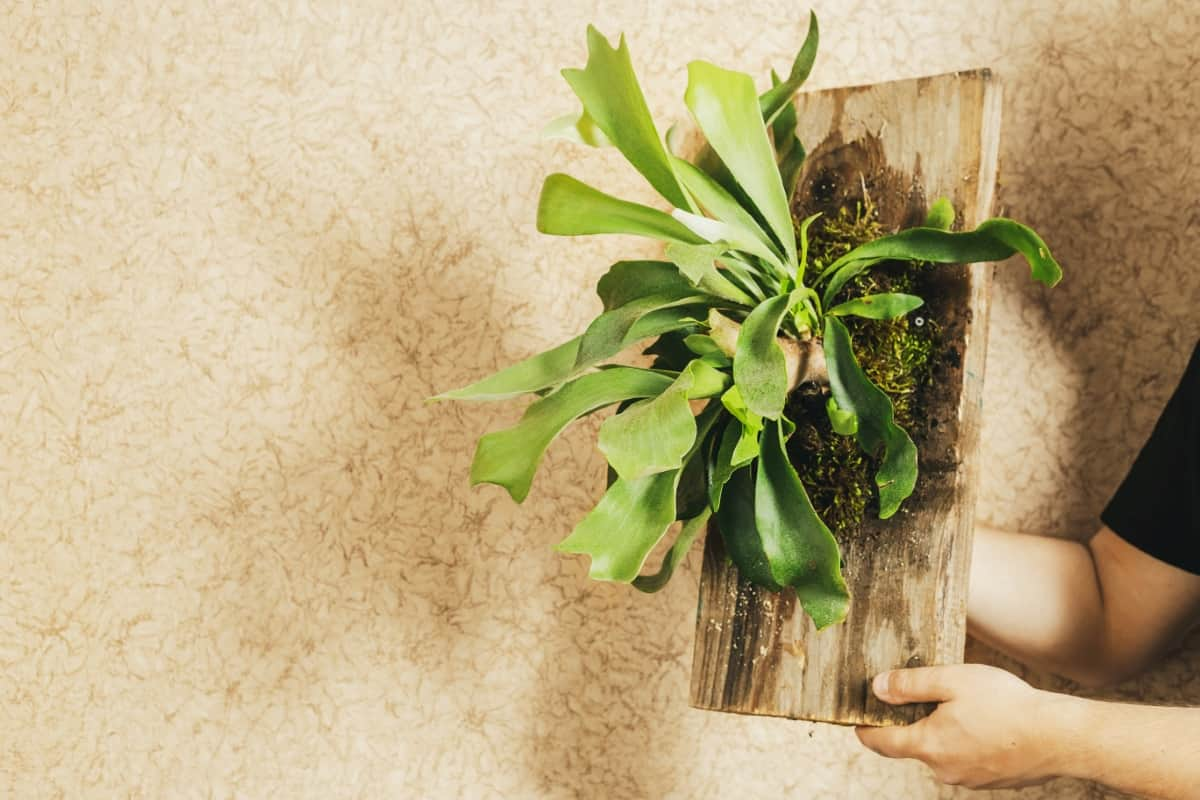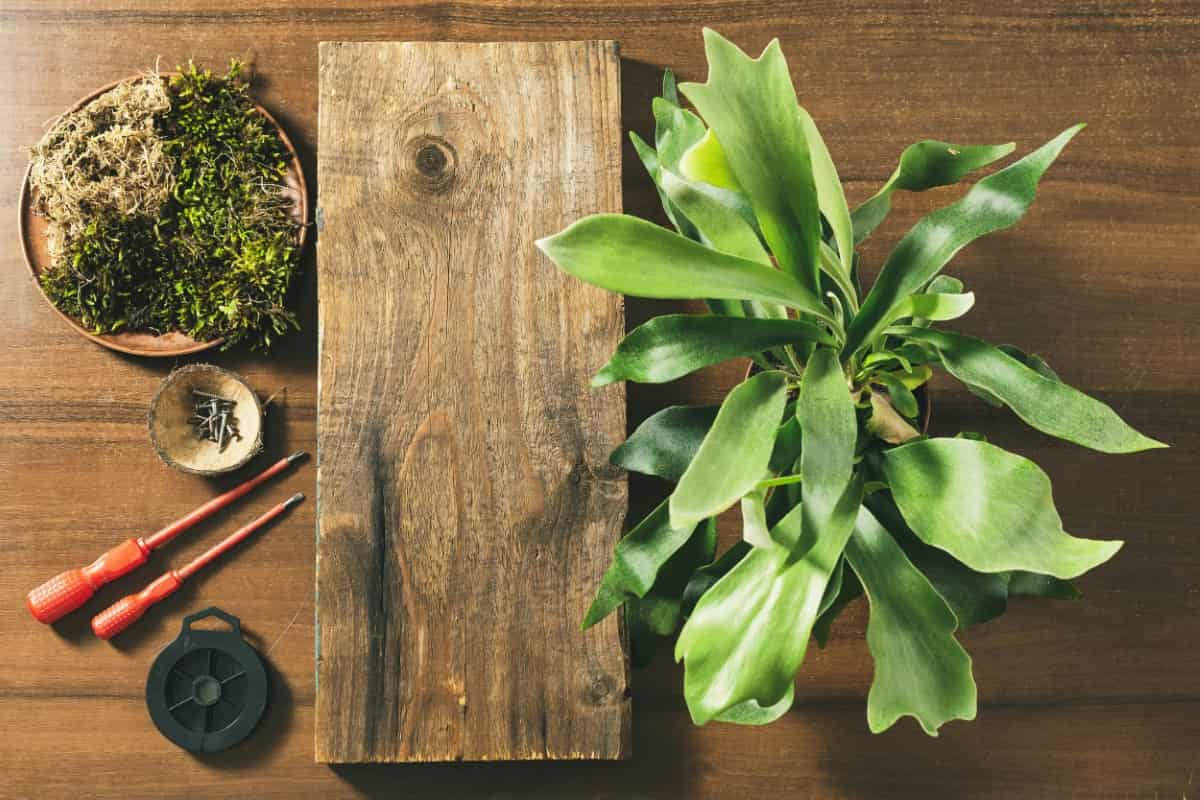Their unique appearance makes Staghorn ferns a captivating addition to any home or garden. To ensure the well-being of your Staghorn ferns, it’s important to provide them with proper care and attention. Whether you keep them outdoors or indoors, following the below tips will help you maintain healthy and vibrant plants.

Staghorn Fern Care
Understanding the Staghorn Fern: Unique Characteristics and Habitat Requirements
One of the most distinctive features of Staghorn ferns is their fronds, which resemble the antlers of a stag deer. The two distinct types are shield fronds that grow at the base and provide support and fertile fronds that extend outward like branching antlers. This dual-frond structure makes them stand out among other ferns.
Staghorn ferns naturally grow on trees or rocks in tropical rainforests. Their ability to cling onto surfaces without being parasitic is thanks to specialized structures called holdfasts. These holdfasts anchor the plant securely while also absorbing nutrients from surrounding debris. Furthermore, Staghorn ferns require high humidity levels to flourish successfully.
Information About Growing Staghorn Fern
| Common Name | Staghorn Fern |
| Botanical Name | Platycerium bifurcatum |
| Family | Polypodiaceae |
| Plant Type | Fern |
| Sun Exposure | Partial |
| Soil Type | Acidic |
| Hardiness Zones | 9–12 (USDA) |
Choosing the Right Location: Providing Optimal Light, Temperature, and Humidity
Choosing the right location for your Staghorn fern is crucial in ensuring its optimal growth and health. These unique plants thrive in specific lighting, temperature, and humidity conditions. When it comes to light, Staghorn ferns prefer bright but indirect sunlight. They can also tolerate some shade but avoid placing them in full sun, which can scorch their delicate fronds. A north or east-facing window is often ideal for providing the right amount of light.
Staghorn ferns do well in average room temperatures ranging from 18 to 24°C. Avoid exposing them to extreme cold or hot drafts, harming their health. Humidity is another important factor for these ferns. Staghorns are native to tropical rainforests where humidity levels are high. To mimic their natural habitat, use a humidifier or place a tray filled with water near the plant. Misting the fronds regularly also helps increase humidity around the plant.
Mounting and Potting Options: Selecting the Best Method to Support Staghorn Ferns
One popular option is mounting on a wooden board or plaque. This allows the fern to mimic its natural habitat, as they typically grow on trees in the wild. You can use cork bark or tree fern fiber to anchor the plant. Another method is using wire baskets or mesh pots. This provides good air circulation while allowing the fern roots to attach themselves securely. If you prefer potting your Staghorn fern, consider using a well-draining medium such as orchid mix or sphagnum moss mixed with perlite.
In case you missed it: Boston Fern Care: Pruning, Winter Care, Fertilization, and Watering Tips

Propagation Methods: Multiplying Your Staghorn Fern with Division
To begin the propagation process of Staghorn, carefully remove the mature plant from its mounting or pot. Once clean, examine the plant for natural divisions – areas where separate growth clumps are visible. Carefully separate these clumps into individual sections using a sharp knife or shears. Each section should have adequate fronds and root mass to sustain itself as it grows. Take caution not to damage too many fronds during this process.
Once divided, you can mount each section individually or place them in small pots filled with a well-draining soil mix. Keep your newly propagated Staghorn ferns in a warm and humid environment until they become established. Mist regularly to maintain humidity levels and provide indirect sunlight for optimal growth.
Potted Staghorn Fern and Staghorn Fern Care Indoors
Care for potted Staghorn Ferns has become increasingly popular as indoor plants, adding a touch of unique greenery to any space. While Staghorn Ferns enjoy high humidity levels, they don’t like sitting in soggy soil. They can tolerate slightly cooler temperatures but should be protected from frost and extreme cold.
Humidity is another important consideration when caring for your potted Staghorn Fern indoors. You can place a tray filled with water nearby or mist its fronds regularly. Staghorn Fern Care indoor benefits from regular feeding with a balanced liquid during the growing season. In terms of maintenance, keep an eye out for dead or yellowing fronds and remove them promptly by trimming at the base without damaging surrounding healthy foliage.
Watering Techniques: Proper Moisture Management for Healthy Staghorn Ferns
One of the key factors in successfully caring for Staghorn ferns is proper moisture management. These unique plants have specific watering needs that ensure their health and vitality. When watering your Staghorn fern, it’s important to strike a balance. Overwatering can lead to issues, while underwatering can cause dehydration and wilting. The goal is to keep the soil moist but not soggy.
To achieve this balance, water your Staghorn fern thoroughly. This usually means watering once or twice a week during warmer months and less frequently during cooler periods. Be sure to use room temperature or slightly warm water, as cold water can shock the plant. Another important aspect of proper moisture management is humidity control.
In case you missed it: How to Grow Succulent Seeds: Easiest and Fast Growing Succulents from Seed

Staghorn ferns benefit from occasional deep soaking sessions. This involves submerging the entire plant in room-temperature water for about 30 minutes every few weeks. Remember that each Staghorn fern may have slightly different moisture requirements based on size and environment, so monitoring your plants closely and adjusting your watering routine is essential.
Fertilizing Strategies: Nourishing Your Staghorn Ferns for Optimal Growth
It’s important to choose the right fertilizer for your ferns. To apply the fertilizer, dilute it according to the manufacturer’s instructions and gently pour it over the base of the fern or onto its mounting material. It’s also important not to over-fertilize your Staghorn Ferns, as this can lead to nutrient burn. In addition to using a balanced fertilizer, consider supplementing with organic matter such as compost or worm castings. These natural additives provide essential nutrients while promoting soil health.
Another strategy is to fertilize during periods of active growth, typically in spring and summer. This will give your Staghorn Ferns an extra boost when they need it most. Remember that every plant is unique, so pay attention to how your fern responds to fertilization. Depending on individual needs, adjusting the frequency or strength of applications may be necessary.
Pruning and Trimming: Maintaining the Shape and Health of Staghorn Ferns
When it comes to pruning, you’ll want to focus on removing dead or dying fronds. Their brown or yellow coloration can easily identify these. Removing these unproductive fronds allows the plant to redirect its energy toward new growth. Trimming important to use clean and sharp gardening tools when trimming your Staghorn ferns to minimize damage and prevent the spread of disease.
Staghorn ferns have a unique growth habit, producing multiple types of fronds – basal shield fronds for support and fertile fronds for reproduction. Removing too many fertile fronds can hinder the plant’s ability to reproduce.
Pest and Disease Management in Staghorn Ferns
Pest and disease management is crucial to caring for your Staghorn ferns. These unique plants are not immune to common pests such as aphids, mealybugs, and scale insects. If you notice any signs of infestation, taking immediate action is essential. Natural remedies are one effective method of controlling pests on your Staghorn fern. For example, spray a solution with mild soap and water onto the affected areas. This will help suffocate the pests without causing harm to your plant.
In case you missed it: 10 Common Problems With Indoor Succulents: How to Fix, Treatment and Solutions

Regularly inspecting your Staghorn fern for any signs of disease is also important. Look for yellowing or wilting fronds, brown spots, or mold growth. If you spot any issues, promptly remove the affected portions to prevent further spread. Maintaining proper hygiene in your plant care routine can go a long way in preventing pest and disease problems from occurring in the first place. Avoid over-watering your Staghorn ferns, as excess moisture can lead to fungal infections.
Conclusion
Staghorn ferns, with their striking yet delicate appearance, are truly a marvel of nature. These epiphytic ferns belong to the Platycerium genus and can be found in around 18 different species. How to care for Staghorn Fern? Staghorn ferns are unique plants that require specific care to thrive. To ensure your Staghorn fern stays healthy, it’s essential to understand its specific needs and provide the right conditions.
- Feed Your Flock for Less: Top 10 Tips to Save on Chicken Feed
- Ultimate Guide to Ossabaw Island Hog: Breeding, Raising, Diet, and Care
- Hatching Answers: The Top 10 Reasons Your Chickens Aren’t Laying Eggs
- Eggs and Economics: Breaking Down the Cost of Raising Backyard Chickens
- Defend Your Greens: Proven Methods to Keep Iguanas Out of Your Garden
- Ultimate Guide to Cinnamon Queen Chicken: A Comprehensive Guide for Beginners
- Ultimate Guide to California Tan Chicken: Breeding, Raising, Diet, Egg-Production and Care
- Ultimate Guide to Marsh Daisy Chicken: Breeding, Raising, Diet, and Care
- 10 Types of Chicken Farming Businesses You Can Start for Profits